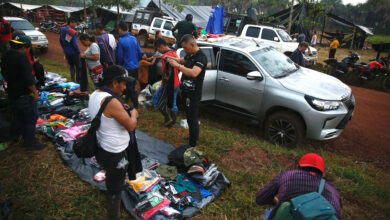The physical, mental scars of Yemen’s drawn-out war

By Yahya Arhab
Sana’a, Feb 10 (EFE).- Last year, Abdul-Hafeez Jobran narrowly avoided death after the bus he was traveling on near Marib in northern Yemen was caught in an airstrike that hit the road the vehicle had taken to avoid the battlefronts between Houthi rebels and Saudi-backed government forces.
The 23-year-old second-year science student was lucky to escape alive as one of three survivors who were injured in the bombing that killed five people.
“I was hospitalized for treatment where doctors decided to amputate my right arm and feet. I lost the cornea of my eye and my left arm is broken,” Jobran tells epa-efe from his wheelchair at a Houthi-run rehabilitation center in Sana’a, his face and chest peppered with shrapnel scars.
“My life has changed. I can’t walk. I can’t do anything. This was because of the attack,” Jobran explains, blaming the Saudi-UAE led coalition for causing his disability.
But Jobran refuses to let that tragedy define his life.
“I am now getting the treatment and exercises at the prosthetic limb center so that I can try out an artificial leg,” he says.
The center says over 24,250 people were given physiotherapy as well as prosthetic limbs in 2021.
The World Health Organization estimates at least 4.5 million people — 15% of Yemen’s 30-million population — suffer from some kind of disability, although the actual figure is likely to be much higher.
There are two other artificial limbs centers in war-ridden Yemen manufacturing prosthetic devices and offering physical rehabilitation services to amputees, in Marib and the southwestern city of Taiz, which are both in government-held territories.
In a narrow room on his first day in the center, Jobran receives physiotherapy as well as psychosocial support from a health worker.
In a few weeks, he will be moved on to a nearby hall where others are trained to use the new prosthetic limbs, including Houthi fighter Hamid Al-Masuri.
Al-Masuri, 35, lost his left leg to shrapnel about a year ago when his position was hit on the southern outskirts of Marib, where the Houthis are launching a ground offensive in the quest for control of the oil-rich province, the Saudi-UAE backed Yemeni government’s last northern stronghold.
“Suddenly a plane fired a missile near me and my leg was cut,” Al-Masuri explains during a break from learning to walk with a prosthetic leg that he received two months ago.
He can already walk steadily without the crutches that he had needed since March 2021, which marked the sixth anniversary of the Saudi-UAE led military campaign on the Houthis.
“Now my mood is improving day by day. When I was injured, I was very, very frustrated. It is difficult and needs a lot of patience”, Al-Masuri says. “If I can work again, I might go back to farming in my village. If I can no longer work, I will stay at home”.
According to the Houthis-held national center for mine action’s recent statistics, the toll of victims of mines and explosives in Houthis-controlled areas in northern Yemen has reached over 3,841 civilians, including at least 1,190 killed between 2015 and 2021.
One of the victims is 42-year-old Ahmed Hamid. He stepped on a mine while walking through a village in Hajour, in the northwestern province of Hajjah, a few weeks after the Houthis suppressed an armed tribal rebellion there in March 2019.
Holding his crutches in the center, Hamid tells epa: “This leg was seriously injured and the other one too. People took me to a nearby health center where my leg was amputated.”
“I still get pain here and here,” he says, pointing to his legs and waist.





